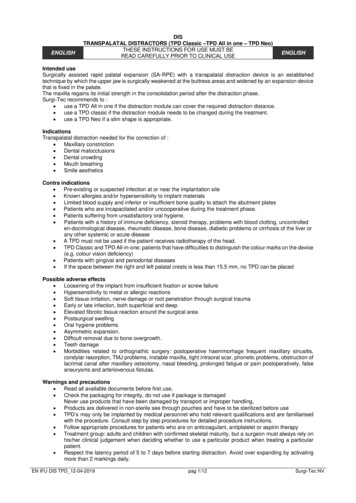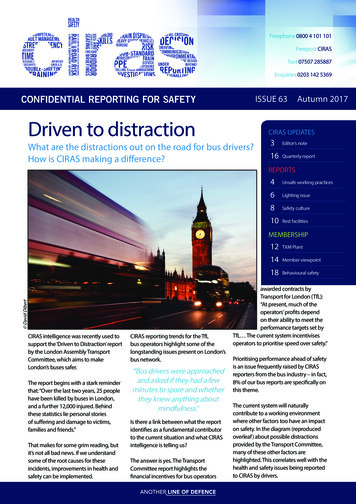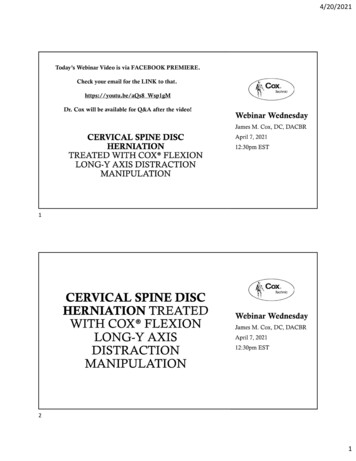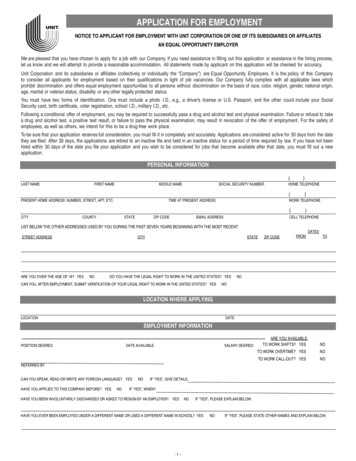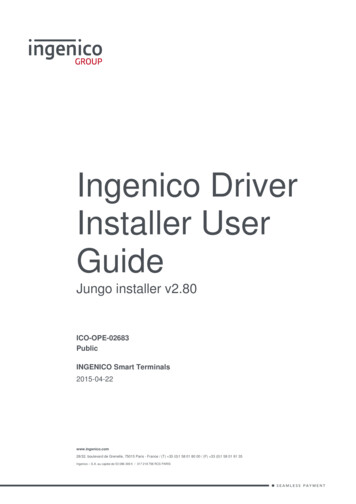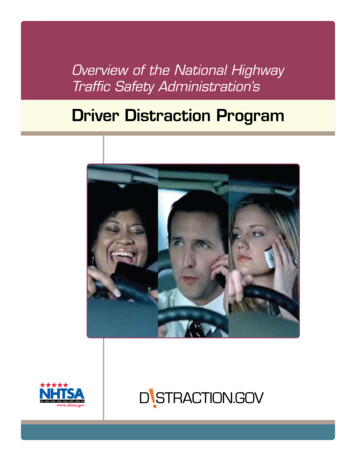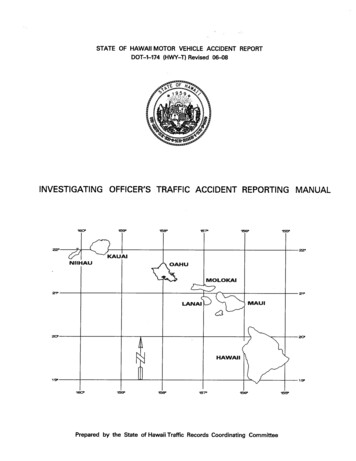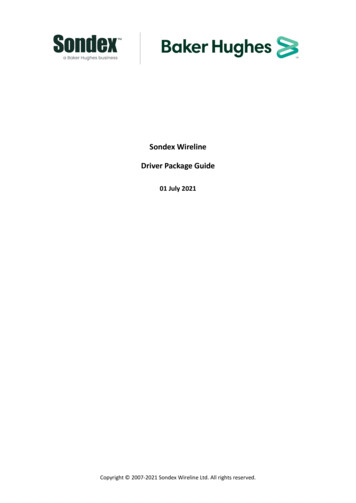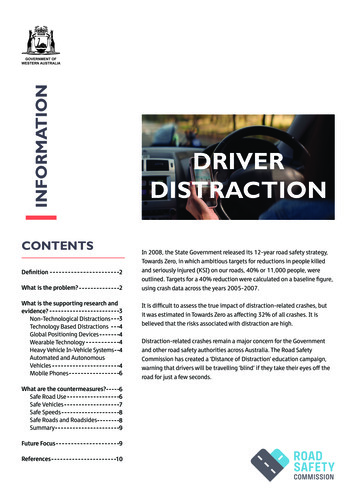
Transcription
t is the problem?2What is the supporting research and3evidence?Non-Technological Distractions 34Technology Based DistractionsGlobal Positioning Devices44Wearable TechnologyHeavy Vehicle In-Vehicle Systems 4Automated and AutonomousVehicles46Mobile PhonesWhat are the countermeasures?Safe Road UseSafe VehiclesSafe SpeedsSafe Roads and RoadsidesSummary667889Future Focus9References10In 2008, the State Government released its 12-year road safety strategy,Towards Zero, in which ambitious targets for reductions in people killedand seriously injured (KSI) on our roads, 40% or 11,000 people, wereoutlined. Targets for a 40% reduction were calculated on a baseline figure,using crash data across the years 2005-2007.It is difficult to assess the true impact of distraction-related crashes, butit was estimated in Towards Zero as affecting 32% of all crashes. It isbelieved that the risks associated with distraction are high.Distraction-related crashes remain a major concern for the Governmentand other road safety authorities across Australia. The Road SafetyCommission has created a ‘Distance of Distraction’ education campaign,warning that drivers will be travelling ‘blind’ if they take their eyes off theroad for just a few seconds.
DEFINITIONThere are four broad categories of distraction from the driving task:1. manual distraction: tasks that require the driver to take a hand (or both hands) off the steering wheel andmanipulate a device (eg. a mobile phone);2. visual distraction: tasks that require the driver to look away from the roadway to visually obtain information (eg.looking in the glovebox);3. auditory distraction: occurs when the driver focuses their attention on auditory signals rather than on the roadenvironment (eg. children in the back seat);4. cognitive distraction: tasks that are defined as the mental workload associated with a task that involves thinkingabout something other than the driving task (National Highway Traffic Safety Administration, 2010).There is also evidence that mixed distraction affects pedestrians and other vulnerable road users crossing roads (Hobday,2017; Mwakalonge, 2015).WHAT IS THE PROBLEM?The National Transport Commission provides the following definition for distracted driving: ‘Driver distraction is thevoluntary or involuntary diverting of attention, in a visual, manual, auditory or cognitive sense, away from the drivingtask to focus on a competing secondary activity.’ (National Transport Commission, 2018).Distracted driving is any activity that diverts attention from driving, including talking or texting on the phone, eatingand drinking, talking to people in the vehicle, fiddling with the stereo, entertainment or navigation system, looking atsomething on the side of the road—anything that takes the driver’s attention away from the task of safe driving.However, it is important to note that distraction affects all road users in a broader sense. Road users other than driversmay be distracted. There is some evidence that distracted pedestrians are at risk when crossing roads (Hobday, 2017).Cyclists and motorcycle riders are also vulnerable.In 2017, it’s estimated that 77% of people killed or seriously injured were in crashes which involved a person making anerror, a lapse in concentration, distraction, fatigue, judgement error or inattention. Only about 23% of people were killedor seriously injured in crashes that involved the primary risk taking behaviours of speeding, drink driving or not wearing ahelmet or restraint.Since 2005-2007, the number of people killed or seriously injured in crashes that involve primary risk taking havereduced by 48%, but only by 23% in crashes that involved mistakes, errors, distraction or poor judgement etc.This reflects a tremendous improvement in community attitudes and behaviour to taking known risks. However,inadvertent errors, including distraction, are more difficult behaviours to change as they are often unintentional, andcontinue to be a significant issue in road trauma.In 2017, 28 people lost their lives in crashes where the WA Police Force believed inattention was a factor. This wasa 112% increase compared to the preceding five-year average, driven largely by inattention-related fatalities in themetropolitan area, which more than doubled in 2017 compared to the preceding five-year average.2
WHAT IS THE SUPPORTING RESEARCH ANDEVIDENCE?Monash University Accident Research Centre and the Traffic and Road Safety Research Group at University of New SouthWales are currently working on a long-running Australian Naturalistic Driver Study (ANDS) using data collected fromvehicles in New South Wales and Victoria.ANDS data revealed that driver engagement in secondary tasks is frequent. On average, drivers engage in a secondarytask every 1.6 minutes. Almost one quarter (23.9%) of the secondary task events involved the driver engaging inmultiple tasks at once. When multiple tasks were undertaken, this typically included drivers interacting with passengerswhile also performing other tasks.Only 5% of the secondary tasks’ events were associated with a driving incident. Many of these incidents involved a delayin drivers detecting that the traffic lights had turned green or that vehicles in front had moved away. However, severalincidents were more serious, with drivers veering out of their lane or failing to detect the vehicle ahead braking suddenly.Only 4.2% of driving time was used to hold, manipulate or talk on a mobile phone while holding the phone. The ANDSstudy highlights the extent to which distracted driving is a part of everyday life in Australia.Non-Technological DistractionsDrivers often engage in activities that, while legal, can potentially distract them from the driving task and therefore limittheir ability to maintain proper control of the vehicle. These activities include eating, drinking, smoking and interactingwith passengers.For example, studies have revealed that a proportion of drivers involved in traffic accidents are distracted by eating ordrinking and have found that an activity such as eating a cheeseburger while smoking and driving can increase the risk ofbeing involved in a crash (Regan, 2003). Several studies have revealed that the presence of passengers can increase crashrisk for young drivers due to distraction, to the point where they were less likely to detect traffic light changes or roadsigns (Regan, 2003). A recent meta-analysis found that talking to passengers had a similar effect to talking on a mobilephone (Caird, 2018).A 2006 National Highway Traffic Safety Authority report on distraction found risk of collision increased by 9 times whenreaching for a moving object inside the vehicle and around 4 times when looking at an external object (Research andEducation Program of Kingston FaLAPH, 2007).Advertising is an external factor that can distract drivers from the driving task. Evidence suggests that roadsideadvertising can adversely influence driver attention, with some evidence that electronic billboards attracted longerglances from drivers than regular traffic signs (Dukic, 2013). Western Australian research in 2018 found that digitalbillboards significantly adversely affected driving performance in the areas of mean speed, speed variability, high riskheadway, variability in lane positioning and visual fixations (Meueleners, 2018).Although studies have not conclusively determined whether electronic billboards constitute a traffic safety hazard,several Australian jurisdictions have developed guidelines and manuals to determine the advertising device types thatmay be permitted on roads based on technical criteria (Mainroads, 2018).3
Technology-Based DistractionsNew forms of mobile and in-vehicle technology are constantly developing, and the laws and guidelines addressing thesepotential distractions lag behind. The National Transport Commission is currently undertaking a major review of allmobile and in-vehicle technologies that may distract drivers (NTC, 2018).Global Positioning DevicesThere are no reliable sources of statistics for crashes caused by GPS-related distracted driving, but some experimentalstudies have found that GPS-assisted driving degrades driving performance, particularly with the use of visual navigationaids. These studies found this situation comparable to driver distraction while driving with a mobile phone (Brown andLaurier, 2012).Wearable TechnologyStudies on the impacts of wearable technology are still limited. However, a study on the safety of wearing a smartwatchwhile driving found that drivers glanced more frequently towards their smartwatch compared with their smartphone(Giang et al., 2015). The same study also found that drivers’ brake response times were longer when receiving anotification prior to a lead vehicle braking event on the smartwatch compared with the smartphone.Heavy Vehicle In-Vehicle SystemsThe technology heavy vehicle drivers interact with on a regular basis includes navigation devices, fuel-economy coachingappliances, fleet management and workflow devices, in-cab fleet tracking and communication systems and, morerecently, electronic logging devices.The National Heavy Vehicle Regulator issued a call for improved road safety following an increase in the number offatalities and incidents involving trucks. The National Heavy Vehicle Regulator urged the heavy vehicle industry todevelop strategies that emphasise reducing distractions on the road (Safety Institute of Australia, 2018). The presence ofemerging mobile technology in heavy vehicles has become more prevalent in recent years.Automated and Autonomous VehiclesAutomated systems can compensate for some forms of driver distraction, such as lane departure warnings. On the otherhand, some in-vehicle technology may in itself lead to distraction. For example, a survey of 57,000 drivers of vehiclesfitted with blind spot monitoring found that the majority of drivers were satisfied with the technology, but a minoritycomplained that the system was distracting and annoying (Palamara, 2018).Currently no fully autonomous vehicles, classified as level 5 on the scale of autonomous vehicles, exist. Vehicles thatinclude partial automation but which assume the driver remains alert may increase distractions as the driver is lessinvolved in the driving process and has more opportunity to instead undertake other distracting activities.4
Image One: Levels of Autonomous DrivingPartially automated vehicles – those at Level 2 of automation – are designed to optimise driver comfort and safety,but require a human driver to remain on standby when the vehicle is in autonomous mode. That means paying closeattention to the driving environment, and taking back control of the vehicle if required.Bored drivers tend to engage spontaneously in distracting activities that stimulate them, such as using a phone, readinga magazine or watching a movie. This may be especially true if the driver feels a high level of trust in the automation(Cunningham, 2015).Simulator tests of partially automated driving where the driver's only task is to monitor the system show significanteffects on eye tracking parameters (blink frequency, blink duration, pupil diameter) and increased mind wandering(Korber, 2015). Real world studies which monitored partially automated vehicles showed that drivers were likely to divertattention to particularly risky activities, such as reading or using mobile phones (Cunningham, 2015).There may be a need for partially automated systems to be fully described to drivers, so that they are educated ontheir limitations. Some providers are also experimenting with requiring drivers to demonstrate their engagementintermittently, by, for instance, touching the steering wheel.5
Mobile PhonesThe growth in level of ownership and use of mobile phones has created a pervasive cause of driver distraction. A 2018meta-analysis found that the effects of using a mobile phone are comparable effect to talking to passengers (Caird,2018).Drivers who look at their mobile phones while driving are three times more likely to be involved in a crash than non-users(Dingus et al., 2016). Dialling, or even locating and answering a hand-held phone, increases the chances of having acrash by four times (Simmons, Hicks and Caird, 2016). Texting, browsing and emailing on a mobile phone while drivingincreases crash risk significantly (Caird, 2014).Mobile phone behaviour and attitudes were surveyed by the Road Safety Commission in 2018 and it was found that: 48% never use a mobile phone handset while driving. 22% had typed a text while driving in the past year. 20% had made a call holding a handset while driving in the past year. 25% had taken a call on handset while driving in past year. 49% believe there’s a high chance of getting caught using a mobile phone while driving.A recent survey by the Australian Government found that 64% of respondents report using their mobile phone whiledriving, including 40% who make calls while driving and 21% who use their mobile phone for other activities such asbrowsing the internet and taking photos (Department of Infrastructure, Regional Development and Cities, 2018). Thesame survey also shows a significant increase in the proportion of participants considering ‘driving distraction/drivingwhile on a mobile’ as the main factor leading to road crashes, growing from 8% in 2013 to 18% in 2017.Mobile phones are also a distraction for pedestrians and are associated with increased risk of pedestrian injury (Hobday,2017). A Brisbane survey of pedestrians found that smart phone use while walking and crossing the road was high,especially among 18-30 year olds (Williamson, 2015).WHAT ARE THE COUNTERMEASURES?Given the complexity of distraction as a road safety issue, counter-measures to address distraction must work within allthe cornerstones of the Safe System.Safe Road UseAustralian legislation relating to distracted driving dates back to 1999, but has not kept pace with the evolution ofsmartphones and modern in-vehicle technologies. The National Transport Commission is currently undertaking a reviewof the Australian Road Rules relating to road user distraction to clarify the law.Currently there are Western Australian road rules specifically about the use of mobile phones and more generallyprohibiting driving without proper control of the vehicle or careless driving.6
Enforcing the road rules for driver distraction can be difficult in situations in which there is limited visibility of what isoccurring inside vehicles. In addition, there is no feasible way to ensure that a driver’s attention remains sufficientlyfocused on the driving task. Police often use strategies such as motorcycle units and cameras to detect the use ofhandheld phones by drivers.There are steps that individual drivers can take to minimise distraction, such as using apps that block mobile phone usewhile driving.Safe VehiclesThis is a complicated area, with some forms of technology reducing driver distraction and other forms potentiallyincreasing it.On one hand, some new in-vehicle technologies can compensate for distracted driving. For instance, features such as lanedeparture warning can counter act a tendency to drift out of the lane while distracted (Palamara, 2016).There are also specialised systems, currently mostly used in the transport industry, which monitor the driver’s gaze.Distracted drivers, who are not looking ahead, are warned by the systems. This technology is being introduced into thewider passenger vehicle market.Research is currently being undertaken into devices to warn drivers of crossing pedestrians and vice versa. This researchshows some preliminary positive results, but is based on vehicles and pedestrians consistently using linked warningdevices (Coegugnet, 2017).Safe SpeedsThe most straightforward way to reduce deaths and injuries associated with distracted driving is to ensure impact speedsare within the limits of human tolerance. Survivable speed crashes involving unprotected road users such as cyclistsand pedestrians are particularly important – the survivable speed for these crashes is 30km/h. The National Road SafetyAction Plan for 2018-2020 highlights the need to reduce speed limits in areas with high pedestrian and cyclist traffic,an undertaking which would improve distraction-related crashes involving vulnerable road users (Australian TransportCouncil, 2018).Appropriate speeds can be encouraged through vehicle features such as Intelligent Speed Adaptation (ISA) that assistsdrivers to abide by the speed limit. GPS technology linked to a speed zone database allows the vehicle to "know" itslocation and the speed limit on that road. The ISA system provides visual and auditory feedback to the driver if thevehicle exceeds the speed limit.Improvements to roads can also make a significant difference. Main Roads Western Australia is currently beginning aprogram of variable speed limits at the approach to selected intersections.7
Safe Roads and RoadsidesIt is difficult to build roads to specifically address distracted driving. Nonetheless, measures can be taken to provide someprotection or early warning for drivers drifting off the road (Candappa, 2013). The Regional Run-off Road Program hasattempted to improve roads in order to add protection to drivers. Improvements include: Installation of audible edge lines (that produce a bumping sensation and noise if the car drifts to the edge of theroad) Widening of road shoulders on the regional network Flexible wire rope safety barriers.Flexible Wire BarrierRoad Shoulder WideningTactile Audible Road MarkingsThere are also measures that may assist distracted pedestrians while crossing the road. New South Wales and Victoria arecurrently conducting trials of in-ground traffic lights so that pedestrians looking downwards (at mobile phones) still seethe lights.Image Four, Melbourne In-Ground Traffic LightThe Commission is maintaining a watching brief on the interstate pedestrian trials.Additionally, there are efforts to regulate roadside distractions. To this end, Main Roads has guidelines intended tomanage and control roadside advertising ‘so as to ensure that such advertising does not pose a safety hazard to roadusers’ (Main Roads, 2018).8
SummaryEffective counter-measures can be undertaken in the following areas: Safe Speed – Reductions in speed improve road safety outcomes in all areas, including crashes related todistracted driving. Safe Vehicles – In-vehicle technology has the capacity to compensate for driver distraction. However, sometechnologies may be a distraction in themselves and partial automation can lead to drivers losing focus ondriving. These issues require careful management. Safe Roads and Roadsides – Some improvements to road crossings and roadside distractions can be made.Additionally, improvements to roads and roadsides can partially ameliorate the results of distraction-relatedcrashes. Safe Road User Behaviour – Education efforts are ongoing and legislation addressing distracted driving iscurrently being reviewed at a national level.FUTURE FOCUSDistraction is a difficult area to address, as it is often an involuntary behaviour and can be triggered by a wide range ofbehavioural and environmental factors. It is tempting to take a simple approach, by focusing on a single behaviour suchas prohibiting mobile phone use. However, any effective approach needs to be more comprehensive (Young, 2013).National research is being led by the Department of Transport and Main Roads (Queensland). This focuses on the drivingecosystem and the layers of responses by stakeholders. National law reform relating to the Australian Road Rules anddistraction is being led by the National Transport Commission. And, finally, the Commission continues to engage researchinto driver distraction through the ongoing research program.9
Reference:D18-9185Effective Date:30/04/2019Next Review:30/04/2020Author: Emma HawkesOwner:Melissa Watts Assistant Director (Policy)EndorsedMelissa WattsDATE DETAILSENDORSED BY16 APRIL 2019 Revised Hawkes E30 APRIL 2019EndorsedWatts MReferencesAustralian Transport Council, National Road Safety Action Plan, 2018-2020.Birrell, Stewart and Mark Young, ‘The impact of smart driving aids on driving performance and driver distraction’,Transportation Research, Part F, no. 14, 2011, pp. 484–493.Brown, Barry and Eric Laurier, The normal natural troubles of driving with GPS, CHI '12 Proceedings of the SIGCHIConference on Human Factors in Computing Systems, 2012.Caird, Jeff K, et al, ‘A meta-analysis of the effects of texting on driving’, Accident Analysis and Prevention, June 2014.Caird, JK, et al, ‘Does Talking on a Cell Phone, with a Passenger, or Dialing Affect Driving Performance? An UpdatedSystematic Review and Meta-Analysis of Experimental Studies’, Human Factors, 2018.Candappa, N, et al, Designing Safer Roads to Combat Driver Errors – Rural Crashes, September 2013.Coeugnet, Stephanie, et al, ‘A vibrotactile wristband to help older pedestrians make safer street crossing decisions’,Accident Analysis and Prevention, 2017.Cunningham, Mitchell and Michael Regan, ‘Driver Inattention, Distraction and Autonomous Vehicles’, 4th InternationalDriver Distraction and Inattention Conference, November 2015.Dingus, Thomas et al, ‘Driver crash risk factors and prevalence evaluation using naturalistic driving data’, Proceedings ofthe National Academy of Sciences of the United States of America, vol. 113, no. 10, 2016, pp.2636–2641.Dukic, T, ‘Effects of electronic billboards on driver distraction’, Traffic Injury Prevention, vol. 14, no. 5, 2013, pp. 469–476.Giang, Wayne, Inas Shanti, Winnie Chen, Alex Zhou and Birsen Donmez, Smartwatches vs. smartphones: a preliminaryreport of driver behavior and perceived risk while responding to notifications, Proceedings of the 7th InternationalConference on Automotive User Interfaces and Interactive Vehicular Applications, Nottingham, United Kingdom,Association for Computing Machinery, New York, 2015, pp. 154–161.Hobday, Michelle, et al, In-Depth Analysis of Pedestrian Serious Injury Crashes, March 2017.Korber, Moritz, et al, ‘Vigilance Decrement and Passive Fatigue Caused by Monotony in Automated driving’, ProcediaManufacturing, 2015.10
Liu, YC and Ming-Hui Wen, ‘Comparison of head-up display (HUD) vs. head-down display (HDD): driving performanceof commercial vehicle operators’ in Taiwan, International Journal of Human-Computer Studies, vol. 61, no. 5, 2004 pp.679–697.Main Roads Western Australia, Policy and Application Guidelines for Advertising Signs within and beyond State RoadReserves, January 2018.Meuleners, Lynn, P Roberts and Kyle Chow, Electronic Advertising Billboards: A Driver Distraction Simulation Study, March2018.Mwakalonge, Judith et al, ‘Distracted walking: examining the extent of pedestrian safety problems’, Journal of Traffic andTransportation Engineering, August 2015.National Highway Traffic Safety Administration, Overview of the National Highway Traffic Safety Administration’s DriverDistraction Program, 2010.National Transport Commission, Developing Technology-Neutral Road Rules for Driver Distraction, December 2018.Palamara, Peter, Promoting Safe Vehicles to Vulnerable Drivers, June 2018.Regan, Michael et al, Driver distraction: a review of the literature and recommendations for countermeasuredevelopment, Monash University Accident Research Centre, 2003.Regan, MA, A Williamson, R Grzebieta, et al, ‘The Australian 400-Car Naturalistic Driving Study: Innovation in Road SafetyResearch and Policy’, Conference Paper, Proceedings of the Road Safety Research, Policing and Enforcement Conference,Brisbane, August 2013.Research and Education Program of Kingston FaLAPH. Driver distraction: A review of the literature, and Driver Distractionand cell phone use: A policy paper. Kingston: 2007.Safety Institute of Australia, 2018. https://www.nhvr.gov.au/Simmons, SM, A. Hicks and Jeff Caird, ‘Safety-critical event risk associated with cell phone tasks as measured innaturalistic driving studies: A systematic review and meta-analysis’, Accident Analysis & Prevention, vol. 87, 2016 pp.161–69.Strayer, David, Joel Cooper, Madeleine McCarty, Douglas Getty, Camille Wheatley, et al, Visual and cognitive demandsof using Apple’s CarPlay, Google’s Android Auto and five different OEM infotainment systems, AAA Foundation for TrafficSafety, Developing technology-neutral road rules for driver distraction December 2018.Williamson, Ann and Alexia Lennon, Pedestrian Self-Reported Exposure to Distraction by Smart Phones while Walkingand Crossing the Road, Proceedings of the 2015 Australiasian Road Safety Conference, 2015.Young, Kristie L and Paul M. Salmon, ‘Sharing the responsibility for driver distraction across road transport systems: asystems approach to the management of distracted driving’, Accident Analysis and Prevention, 2015.11
using crash data across the years 2005-2007. It is difficult to assess the true impact of distraction-related crashes, but . risk for young drivers due to distraction, to the point where they were less likely to detect traffic light changes or road . high risk headway, variability in lane positioning and visual fixations (Meueleners, 2018).

